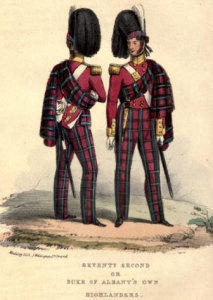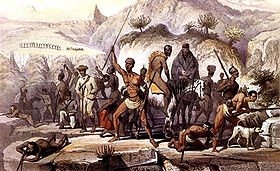WILLIAM YOUNG BLACK (1784-1873) Military Experience
 William Black, the son of William and Mary Gardiner Black. Was born August 20, 1784, at Lisburn, Antrim County, Ireland. At the age of seventeen years, he enlisted in the Seventy-second Regiment of the British Army, also called Duke of Albanys own Highlandrs, in which he served four years in Ireland and seventeen years abroad. A chronological sequence of key events over these twenty one years follows:
William Black, the son of William and Mary Gardiner Black. Was born August 20, 1784, at Lisburn, Antrim County, Ireland. At the age of seventeen years, he enlisted in the Seventy-second Regiment of the British Army, also called Duke of Albanys own Highlandrs, in which he served four years in Ireland and seventeen years abroad. A chronological sequence of key events over these twenty one years follows:
1801 Joined the British Seventy Second Regiment, or Duke of Albanys own Highlanders.
1801- Stationed in Newry, Dublin, and Cork, Ireland
1805 – At sea. 4 gun-ships and 5,000 troops arrived in the Bay of Funclial in Madeira Portugal. Sailed to the Brazils, where the troops were landed at St. Salvador for a few hours for refreshment. Proceeded to the Cape of Good Hope
1806 – Affected a landing at Lospard’s Bay Cape of Good Hope. Advanced against the Dutch troops. Surrender of the colony of the Cape of Good Hope. Authorized to bear the words “Cape of Good Hope” on its Colours and Appointments.
1807 – Stationed at Cape Town for three years.
1808 – Discontinued use of “Highlander” costume
1810 – Marched from Cape Town, South Africa to Stellenbosch, 30 miles East of Cape Town. Formed part of an Expedition with troops from India against the Isle de France (Mauritius). Surrender of the Isle de France. Remained at the Mauritius upwards of three years
1814 – Embarked for the Cape of Good Hope
1815 – Embarked for Calcutta, India. Re-embarked for the Isle de France.
1816 – Proceeded to the Cape of Good Hope.
1817 – Proceeded to Algoa-bay, and engaged in war against the Kaffirs ….
1819 – Fought in Kaffir war (Khosa war)
1821 – Embarked for England
1821 – At sea
1822 – Arrived at Portsmouth, England
1822 – Discharged from service to her Majesty
Historical Record of the 72nd FOOT
From his records; “I landed in England about the first of March and was discharged and arrived at my fathers house on July 2nd of the same year. When I got home my mother, brothers and sisters were all dead: none were left but my father.”
Click here to see references:
Notes:
Cape of Good Hope
William was present at the surrender of the colony of the Cape of Good Hope, South Africa. The Cape of Good Hope is one of the worlds most recognizable traveling posts. Its bordered by the Atlantic Ocean on the East, and is about 30 miles south Cape Town. The Cape of Good Hope was originally named the Cape of Storms by Portuguese explorer Bartholomew Dias in 1488. Dias became the first European to travel around the tip of Africa, but was eventually killed in a sea storm off the Cape in 1500. The Cape was renamed the Cape of Good Hope by Portugals King John II because it allowed an easier trade route with India. The Cape of Good Hope has a reputation for being the southernmost tip of Africa. This distinction belongs to Cap Agulhas, which is the official division point between the Atlantic and Indian Oceans. According to legend, the Cape of Good Hope is also home to the ghost ship the Flying Dutchman. The story goes that if one sees this band of phantom sailors, they are destined for doom.
Mauritius (Isle de France)
William was part of the expedition that overpowered the French and took control of the island of Mauritius by the British. Mauritius is an island nation off the southeast coast of the African continent in the Southwest Indian Ocean, about 560 miles east of Madagascar. The island had for a long time remained unknown and uninhabited. It was probably visited by Arab sailors during the Middle ages, and on maps of about 1500 it is shown by an Arabic name Dina Arobi. The Portuguese sailor Domingo Fernandez Pereira was probably the first European to land on the island at around 1511. The island appears with a Portuguese name on early Portugues maps, probably because of the presence of the Dodo, a flightless bird which was found in great numbers tt that time. The Portugues did not stay long as they were not interested in those islands.
Abandoned by the Dutch, the island became a French colony when, in September 1715, Guillaume Defresen DArsel landed and took possession of this precious port of call on the route to India. He named the Island Isle de France, but it was only in 1721 that the French started their occupation. However, it was only as from 1735, with the arrival of the most illustrious of French Governor, Mahe de La Bourdonnais. During the Napoleonic wars the Isle de France had become a base from which French corsairs organized successful raids on British commercial ships. The raids continued until 1810 when a strong expedition was sent to capture the island. A preliminary attack was foiled at Grand Port in August 1810, but the main attach launched in December of the same year from Rodrigues, which had been captured a year earlier was successful. The British landed in large numbers in the north of the island and rapidly overpowered the French. (William Y Black was part of this expedition). The British administration was followed by rapid social and economic changes. One of the most important events was the abolition of slavery in 1835. The planters received a compensation of two million pounds sterling for the loss of their slaves, which had been imported from Africa and Madagascar during the French occupations. The abolition of slavery had important repercussions on the socioeconomic and demographic fields. The planters turned to India, from where they brought a large number of indentured laborers to work in the sugar cane fields. The Indian immigrants, who were both Hindu and Muslim faith, were to change rapidly the fabric of the society. They were later joined by a small number of Chinese traders. Cultivation of sugar cane was given a boost and the island flourished, especially with the export of sugar to England. Economic progress necessitated the extension and improvement of means of communication and gradually an adequate infrastructure was created
The Khosa Wars
 As Dutch maritime powered declined, British power rose and sought to control trade routes to Asia. The British seized Cape Town in 1795, and the peace treaties of 1815 which ended the Napoleonic wars granted the Cape to Britain. For the British, as it had been for the Dutch, the goal was a colony which could supply their ships to and from Asia. For over 70 years, first the Dutch and then the British fought frontier was with the Xhosa, Bantu speaking farmers. The Xhosa were tougher opponents that the Khoikhoi had been. They were stronger, more numerous, and had better resistance to European diseases. The Khosa had lived in the same way for centuries and made no significant changes when the white settlers arrived. They resisted missionaries attempts to convert them, sometimes with bloodshed, until 1820 when John Brownlee founded a mission on the Tyhume River near Alice, and William Shaw established a chain of Methodist outposts throughout the Transkei. The door was opened to all kinds of missionary activity. The missionary activity weakened the Khosa culture and this, along with disappearing grazing land and a steadily increasing white population, hastened the disintegration of the Khosa.
As Dutch maritime powered declined, British power rose and sought to control trade routes to Asia. The British seized Cape Town in 1795, and the peace treaties of 1815 which ended the Napoleonic wars granted the Cape to Britain. For the British, as it had been for the Dutch, the goal was a colony which could supply their ships to and from Asia. For over 70 years, first the Dutch and then the British fought frontier was with the Xhosa, Bantu speaking farmers. The Xhosa were tougher opponents that the Khoikhoi had been. They were stronger, more numerous, and had better resistance to European diseases. The Khosa had lived in the same way for centuries and made no significant changes when the white settlers arrived. They resisted missionaries attempts to convert them, sometimes with bloodshed, until 1820 when John Brownlee founded a mission on the Tyhume River near Alice, and William Shaw established a chain of Methodist outposts throughout the Transkei. The door was opened to all kinds of missionary activity. The missionary activity weakened the Khosa culture and this, along with disappearing grazing land and a steadily increasing white population, hastened the disintegration of the Khosa.